
Wine Culture and Information since 2002 - Volume 22
 Wine Culture and Information since 2002 - Volume 22 |
|
Contrasts of Cava and ChampagneThis month we are going to pour in our glasses the main representatives of the sparkling wines of Spain and France. Different grapes and different territories having in common the charm of bubbles |
|
In the vast and endless world of wine, sparkling wines have always had a prominent place. Frequently associated with luxury and elegance, bubbles, however, are not – by themselves – enough to give quality to a wine, above all, and in particular, because of the fact not all bubbles are the same. It is, in fact, an enological “world” on its own and making a high quality sparkling wine is not easy. There are many factors determining the quality of a sparkling wine and it is not only about grapes and territory, although these two elements play a very important role. Quality sparkling wines, in fact, require, among many others, a rather high technical knowledge, not only in terms of wine making, but especially in the technical factors needed for the production of this style. In fact, there are many details and technical factors influencing the final result, each of them equally fundamental and critical. Specifically, this is particularly important to the production technique of the sparkling wines protagonists of the tasting by contrast of this month, that is the classic method. In fact, it should be noted the production of sparkling wines is essentially carried out with two distinct and decidedly different methods, both in terms of technique and result: Martinotti or Charmat method and classic method. The two techniques make use of the refermentation of a base wine which, in the first case, is carried out in a closed tank, in the second inside a bottle. The two techniques – in fact – produce remarkably different results and are characterized by very identifying styles and qualities. The wines we will examine in this month's tasting by contrast – Cava and Champagne – are produced with the classic method, therefore with the refermentation in bottle, although in different ways and which are particularly distinguished both for the grapes and production and aging times.
|
|
Cava is Spain's sparkling wine glory and enjoys a good reputation even outside national borders. Cava is recognized by the Spanish quality system as a Denominación de Origen (DO) wine and its production area is Penedés, a wine growing area in Catalonia. The production of this wine is relatively recent and, just like what happened in other parts of the world, it has been influenced by the success of Champagne. History tells that the production of Cava dates back to the mid-1800s, by Josep Raventós, a wine merchant who had commercial relations with France. After visiting the Champagne area, in fact, he was convinced that even in Spain sparkling wines could be created with the classic method, and he therefore managed to market his first Cava in 1872. According to other sources, Cava owes its birth thanks to studies conducted by Luis Justo Villanueva at the Catalan Agriculture Institute of San Isidro on the production of classic method sparkling wines. The first Cava wines are supposed to have been produced with the grapes typically used in Champagne, however the devastation caused by phylloxera in the Penedés territory in 1887 required the reimplantation of local white berried varieties, also replacing the red ones. The change brought by phylloxera therefore influenced the production of Cava, introducing the use of local varieties Macabeo, Parellada and Xarel·lo, which are still fundamental in the modern composition of Cava. The production of this sparkling wine makes use of the refermentation in bottle, therefore using the classic method, in the white and rosé styles. White Cava is produced with Macabeo, Xarel·lo and Parellada varieties as well as Chardonnay and Malvasía, while the rosé style is produced with Monastrell, Garnacha Tinta, Trepat and Pinot Noir. Both styles provide for the refermentation in bottle and subsequent aging for a minimum of 9 months, at least 15 for the reserve style, 30 for the grand reserve and at least 36 for the Cava de Paraje Calificado.
|
||||
|
Champagne, undeniably, is the sparkling wine that more than any other one is capable of evoking refinement and class in a wine. The merit is certainly because of both its long history and the centuries-old promotional skill of the French to make their wines exclusive and precious. To tell the truth, the dominance of Champagne in the world of sparkling wines has for years been disputed by other wine areas of the world and which have shown – with facts – to produce undisputed and certainly not inferior excellence. The secret of the prestige of Champagne remains – in any case – Champagne itself, that is, the territory, unique and unrepeatable, in which this enological magic is born. A complex set of extraordinary elements, made of small territories and each with unique qualities, grapes perfectly suited to sparkling wine, technique and experience, climate, soil composition and the environment as a whole. Chardonnay, Pinot Noir and Pinot Meunier are the main grapes which traditionally – better said, today – are used for the production of Champagne. These grapes, especially the first two, have literally conquered the wine-growing areas of the world where sparkling wines are produced, with the explicit aim of replicating the same quality of Champagne. It must be said, however, both Chardonnay and Pinot Noir are remarkably suited to the production of classic method sparkling wines, however they are just one of the many factors indispensable for the creation of a great refermented sparkling wine in bottle. As for aging times, non-vintage Champagne requires 15 months, of which 12 on lees, while for vintage wines, this time extends to 36 months. Finally, Champagne is produced in different styles, in particular Blanc de Blancs, produced only with white berried grapes, Blanc de Noirs from Pinot Noir and/or Pinot Meunier grapes, as well as Rosé.
|
The choice of the wines for the tasting by contrast of this month is not quite simple and, certainly, not because of their presence in stores. In fact, both Cava and Champagne can be easily found everywhere and, especially French wine, with a wide range of styles. The difficulty, indeed, is represented by the lack of information about their production characteristics as, in most of the cases, in their labels are usually not found information about the grapes or the aging time on the lees. In general terms, however, it can be assumed that – saved when expressly stated in the label – Cava and Champagne are produced with the “minimum requirements ” defined by the respective disciplinary. This means, in most cases, the use of the Macabeo, Xarel·lo and Parellada grapes for Cava; Chardonnay, Pinot Noir and Pinot Meunier for Champagne. We will therefore choose these type of wines, of course non vintage. Cava and Champagne are served at a temperature of 10 °C (50 °F) and poured into tasting glasses. Let's pour Cava and Champagne into their respective glasses and start the tasting by contrast of this month. The first wine we take into consideration is Cava, specifically we evaluate its appearance by observing the qualities of bubbles and foam. By holding the glass in vertical position and, without swirling, we observe the surface of the wine from above, in particular, the so-called crown, that is the formation of the surface foam around the inner side of the glass. The foam shows a medium-fine grain and tends to fade in a pretty quickly way. Let's now raise the glass to eye level and observe the development of bubbles, the so-called perlage. We can see chains of bubbles of medium-small size, in good quantity and persistence. The color of the Cava is brilliant straw yellow and, by tilting the glass over a white surface, the nuance – observed at the edge, towards the opening – is characterized by a greenish yellow color. Let's move on to the evaluation of the appearance of Champagne, starting from the crown: the formation is more compact and fine, however it tends to disappear in a relatively quick way. The perlage is made of very fine bubbles, in greater quantity and persistence than Cava. Finally, the color of Champagne shows an intense straw yellow and the nuance is straw yellow, often golden, deeper than Cava. The description of the olfactory profile of classic method sparkling wines is never simple when considered in a “generic” way. In fact, there are many variables determining the organoleptic profile of these wines as technical factors can often become fundamental and decisive. In fact, it must be considered that, in the whole production process of a classic method sparkling wine – such as Cava and Champagne – the technical factor plays a prominent role. This does not mean the unique and unrepeatable characteristics of the territory and grapes are not important, however they are just one of the many elements contributing to the “technical factor” which is decisive in these wines. From the making of the base wine, to the addition of the so-called liqueur d'expédition, every single phase of the production of a classic method sparkling wine, including – and in particular – time, is capable of giving specific and fundamental sensorial qualities, from appearance to taste. Let's proceed with the evaluation of the olfactory profiles of Cava and Champagne, starting with the Spanish sparkling wine. By holding the glass of the Cava in vertical position and, without swirling, we proceed with the first smell in order to evaluate its opening. From the glass are perceived intense and clean aromas of citrus and flowers, in particular bergamot and chamomile, as well as pear and apple. Let's now swirl the glass and proceed with the second smell. The olfactory profile of Cava is completed with plum, peach and hints of yeast. We now continue with the evaluation of the olfactory profile of Champagne, by evaluating its opening. The glass gives more “mature” aromas than Cava and in which we recognize banana, acacia, apple and bread crust. We swirl the glass, an operation favoring oxygenation and therefore the development of aromas, and do a new smell. The olfactory profile of Champagne is completed with apple, pear, hazelnut and a citrus note that often recalls grapefruit. The olfactory profiles of the two wines express very different characters: Cava is characterized by a fresher and younger nose than Champagne which, on the other hand, has a decidedly more mature profile. Let's move on to the evaluation of the gustatory profiles of Cava and Champagne, in which the differences between the two wines are further evident. Let's take a sip of Cava and evaluate its attack, that is the initial sensations that the wine gives in the mouth. Note the clear effervescence, with, so to speak, an immediate development, followed by the pleasing crispness of the acidity. The wine is decidedly dry and the sensation produced by alcohol is moderate, however enough to make Cava balanced. We also perceive flavors of bergamot, pear and apple. Let's now proceed with the evaluation of the gustatory profile of Champagne and take a sip. The attack of the French wine is characterized by the intense effervescence – although more creamy than Cava – followed by the pleasing crispness of acidity. Compared to the Spanish sparkling wine, the effect of alcohol has a more evident impact as well as the roundness, decidedly more accentuated than Cava. In the mouth we perceive the flavors of banana, apple and grapefruit. Let's end the tasting by contrast of this month with the evaluation of the final sensations the two wines leave in the mouth after swallowing. The finish of Cava is persistent and in the mouth we can still perceive the crisp and young acidity, in addition to the pleasing flavors of bergamot, pear and apple, often combined with plum. The sensation the Spanish sparkling wine leaves in the mouth is of a wine of moderate structure, but decidedly pleasing and immediate. The finish of Champagne is equally persistent and intense, leaving in the mouth the pleasing sensation of acidity and good roundness, as well as flavors of banana, apple and grapefruit. The sensation of structure, even in the final phase of the tasting, is decidedly more intense in Champagne, which is also characterized by a clearly more “mature” and “round” personality. Cava and Champagne – although they are both made with the classic method, that is the refermentation in bottle and subsequent aging on their lees – express rather distant sensorial characteristics and in which, apparently, only bubbles seem to create a link between the two wines.
|
||||||||
Wines of the Month |
|
|
|
Score legend Prices are to be considered as indicative. Prices may vary according to the country or the shop where wines are bought |

|
|
Colli Orientali del Friuli Pinot Bianco Zuc di Volpe 2018 |
|
| Volpe Pasini (Friuli-Venezia Giulia, Italy) | |
 Pinot Bianco Pinot Bianco | |
| Price: € 22.90 | Score: |
 Brilliant straw yellow and nuances of straw yellow, very transparent. Brilliant straw yellow and nuances of straw yellow, very transparent. Intense, clean, pleasing, refined and elegant, starts with hints of
apple, pear and acacia followed by aromas of pineapple, hawthorn, peach,
white rose, broom, lemon, plum, hazelnut and mineral. Intense, clean, pleasing, refined and elegant, starts with hints of
apple, pear and acacia followed by aromas of pineapple, hawthorn, peach,
white rose, broom, lemon, plum, hazelnut and mineral.
 Crisp attack and however balanced by alcohol, good body, intense
flavors, agreeable. Crisp attack and however balanced by alcohol, good body, intense
flavors, agreeable.
 Persistent finish with flavors of apple, pineapple and peach. Persistent finish with flavors of apple, pineapple and peach. Aged in steel tanks. Aged in steel tanks. |
|
 Pasta with fish and vegetables, Sauteed fish, Sauteed white meat, Fried fish, Dairy products Pasta with fish and vegetables, Sauteed fish, Sauteed white meat, Fried fish, Dairy products |
|

|
|
Colli Orientali del Friuli Merlot Focus Zuc di Volpe 2015 |
|
| Volpe Pasini (Friuli-Venezia Giulia, Italy) | |
 Merlot Merlot | |
| Price: € 32.50 | Score: |
 Deep ruby red and nuances of garnet red, little transparency. Deep ruby red and nuances of garnet red, little transparency. Intense, clean, pleasing, refined and elegant, starts with hints of
black currant, black cherry and violet followed by aromas of blueberry,
plum, cocoa, tobacco, licorice, leather, mace, vanilla and menthol. Intense, clean, pleasing, refined and elegant, starts with hints of
black currant, black cherry and violet followed by aromas of blueberry,
plum, cocoa, tobacco, licorice, leather, mace, vanilla and menthol.
 Properly tannic attack and however balanced by alcohol, good body,
intense flavors, pleasing roundness. Properly tannic attack and however balanced by alcohol, good body,
intense flavors, pleasing roundness.
 Persistent finish with flavors of black currant, black cherry and
blueberry. Persistent finish with flavors of black currant, black cherry and
blueberry.
 12 months in barrique, 12 months in bottle. 12 months in barrique, 12 months in bottle. |
|
 Roasted meat, Braised and stewed meat, Hard cheese Roasted meat, Braised and stewed meat, Hard cheese |
|
|
|
|
Nasco di Cagliari Montesicci 2018 |
|
| Cantine di Dolianova (Sardinia, Italy) | |
 Nasco Nasco | |
| Price: € 8.80 | Score: |
 Intense straw yellow and nuances of straw yellow, very transparent. Intense straw yellow and nuances of straw yellow, very transparent. Intense, clean, pleasing, refined and elegant, starts with hints of
apple, plum and citrus fruits followed by aromas of hawthorn, peach,
pineapple, jasmine, honey, praline, broom, almond and vanilla. Intense, clean, pleasing, refined and elegant, starts with hints of
apple, plum and citrus fruits followed by aromas of hawthorn, peach,
pineapple, jasmine, honey, praline, broom, almond and vanilla.
 Crisp attack and however balanced by alcohol, good body, intense
flavors, pleasing roundness. Crisp attack and however balanced by alcohol, good body, intense
flavors, pleasing roundness.
 Persistent finish with flavors of apple, plum and peach. Persistent finish with flavors of apple, plum and peach. 12 months in cask. 12 months in cask. |
|
 Stuffed pasta with mushrooms, Roasted fish, Roasted white meat, Cheese Stuffed pasta with mushrooms, Roasted fish, Roasted white meat, Cheese |
|

|
|
Moscato di Sardegna Passito 2014 |
|
| Cantine di Dolianova (Sardinia, Italy) | |
 Moscato Bianco Moscato Bianco | |
| Price: € 15.80 - 375ml | Score: |
 Brilliant amber yellow and nuances of amber yellow, transparent. Brilliant amber yellow and nuances of amber yellow, transparent. Intense, clean, pleasing, refined and elegant, starts with hints of
raisin, dried apricot and dried fig followed by aromas of citrus fruit
peel, peach jam, quince jam, honey, date, candied fruits, lavender, lychee,
almond, sage and nail polish. Intense, clean, pleasing, refined and elegant, starts with hints of
raisin, dried apricot and dried fig followed by aromas of citrus fruit
peel, peach jam, quince jam, honey, date, candied fruits, lavender, lychee,
almond, sage and nail polish.
 Sweet and round attack, however balanced by alcohol, good body, intense
flavors, pleasing crispness. Sweet and round attack, however balanced by alcohol, good body, intense
flavors, pleasing crispness.
 Persistent finish with flavors of raisin, dried apricot and dried fig. Persistent finish with flavors of raisin, dried apricot and dried fig. Aged in steel tanks. Aged in steel tanks. |
|
 Confectionery, Jam tarts, Hard cheese Confectionery, Jam tarts, Hard cheese |
|

|
|
Cannonau di Sardegna Riserva Fola 2017 |
|
| Siddura (Sardinia, Italy) | |
 Cannonau Cannonau | |
| Price: € 20.50 | Score: |
 Brilliant ruby red and nuances of garnet red, little transparency. Brilliant ruby red and nuances of garnet red, little transparency. Intense, clean, pleasing, refined and elegant, starts with hints of
plum, black cherry and blueberry followed by aromas of violet, raspberry,
blackberry, chocolate, tobacco, mace, vanilla and menthol. Intense, clean, pleasing, refined and elegant, starts with hints of
plum, black cherry and blueberry followed by aromas of violet, raspberry,
blackberry, chocolate, tobacco, mace, vanilla and menthol.
 Properly tannic attack and however balanced by alcohol, good body,
intense flavors, pleasing roundness. Properly tannic attack and however balanced by alcohol, good body,
intense flavors, pleasing roundness.
 Persistent finish with flavors of plum, black cherry and blueberry. Persistent finish with flavors of plum, black cherry and blueberry. Aged in cask. Aged in cask. |
|
 Stuffed pasta, Broiled meat and barbecue, Roasted meat, Stewed meat with mushrooms, Hard cheese Stuffed pasta, Broiled meat and barbecue, Roasted meat, Stewed meat with mushrooms, Hard cheese |
|

|
|
Vermentino di Gallura Superiore Maia 2018 |
|
| Siddura (Sardinia, Italy) | |
 Vermentino Vermentino | |
| Price: € 20.50 | Score: |
 Brilliant straw yellow and nuances of greenish yellow, very
transparent. Brilliant straw yellow and nuances of greenish yellow, very
transparent.
 Intense, clean, pleasing, refined and elegant, starts with hints of
apple, pear and medlar followed by aromas of hawthorn, citrus fruits,
peach, plum, pineapple, anise, broom and almond. Intense, clean, pleasing, refined and elegant, starts with hints of
apple, pear and medlar followed by aromas of hawthorn, citrus fruits,
peach, plum, pineapple, anise, broom and almond.
 Crisp attack and however balanced by alcohol, good body, intense
flavors, agreeable. Crisp attack and however balanced by alcohol, good body, intense
flavors, agreeable.
 Persistent finish with flavors of apple, plum and almond. Persistent finish with flavors of apple, plum and almond. Aged in steel tanks, Aged in steel tanks, |
|
 Fried fish, Pasta with fish, Stewed fish, Sauteed white meat, Dairy products Fried fish, Pasta with fish, Stewed fish, Sauteed white meat, Dairy products |
|
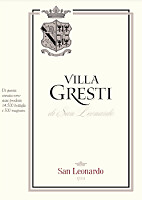
|
|
Villa Gresti 2015 |
|
| Tenuta San Leonardo (Trentino, Italy) | |
 Merlot (90%), Carmenère (10%) Merlot (90%), Carmenère (10%) | |
| Price: € 24.00 | Score: |
 Intense ruby red and nuances of garnet red, little transparency. Intense ruby red and nuances of garnet red, little transparency. Intense, clean, pleasing, refined and elegant, starts with hints of
black currant, black cherry and blueberry followed by aromas of plum,
violet, raspberry, iris, face powder, cyclamen, chocolate, tobacco, bell
pepper, cinnamon, vanilla and eucalyptus. Intense, clean, pleasing, refined and elegant, starts with hints of
black currant, black cherry and blueberry followed by aromas of plum,
violet, raspberry, iris, face powder, cyclamen, chocolate, tobacco, bell
pepper, cinnamon, vanilla and eucalyptus.
 Properly tannic attack and however balanced by alcohol, good body,
intense flavors, pleasing roundness. Properly tannic attack and however balanced by alcohol, good body,
intense flavors, pleasing roundness.
 Persistent finish with flavors of black currant, black cherry and plum. Persistent finish with flavors of black currant, black cherry and plum. 14 months in barrique, 12 months in bottle. 14 months in barrique, 12 months in bottle. |
|
 Broiled meat and barbecue, Stewed meat with mushrooms, Roasted meat, Hard cheese Broiled meat and barbecue, Stewed meat with mushrooms, Roasted meat, Hard cheese |
|
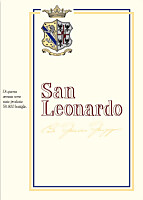
|
|
San Leonardo 2015 |
|
| Tenuta San Leonardo (Trentino, Italy) | |
 Cabernet Sauvignon (60%), Carmenère (30%), Merlot (10%) Cabernet Sauvignon (60%), Carmenère (30%), Merlot (10%) | |
| Price: € 68.00 | Score: |
 Intense ruby red and nuances of ruby red, little transparency. Intense ruby red and nuances of ruby red, little transparency. Intense, clean, pleasing, refined and elegant, starts with hints of
black currant, black cherry and blueberry followed by aromas of violet,
plum, raspberry, green bell pepper, iris, chocolate, peony, face powder,
tobacco, pink pepper, cigar box, vanilla and eucalyptus. Intense, clean, pleasing, refined and elegant, starts with hints of
black currant, black cherry and blueberry followed by aromas of violet,
plum, raspberry, green bell pepper, iris, chocolate, peony, face powder,
tobacco, pink pepper, cigar box, vanilla and eucalyptus.
 Properly tannic attack and however balanced by alcohol, full body,
intense flavors, pleasing crispness and roundness. Properly tannic attack and however balanced by alcohol, full body,
intense flavors, pleasing crispness and roundness.
 Very persistent finish with long flavors of black currant, black cherry
and menthol. Very persistent finish with long flavors of black currant, black cherry
and menthol.
 24 months in barrique, at least 18 months in bottle. 24 months in barrique, at least 18 months in bottle. |
|
 Game, Roasted meat, Stewed and braised meat, Hard cheese Game, Roasted meat, Stewed and braised meat, Hard cheese |
|
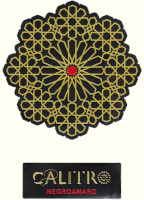
|
|
Negroamaro 2017 |
|
| Vigneti Calitro (Apulia, Italy) | |
 Negroamaro Negroamaro | |
| Price: € 33.00 | Score: |
 Deep ruby red and nuances of ruby red, little transparency. Deep ruby red and nuances of ruby red, little transparency. Intense, clean, pleasing, refined and elegant, starts with hints of
plum, black cherry and blackberry followed by aromas of violet, raspberry,
tamarind, geranium, chocolate, tobacco, mace, vanilla and menthol. Intense, clean, pleasing, refined and elegant, starts with hints of
plum, black cherry and blackberry followed by aromas of violet, raspberry,
tamarind, geranium, chocolate, tobacco, mace, vanilla and menthol.
 Properly tannic attack and however balanced by alcohol, good body,
intense flavors, pleasing roundness. Properly tannic attack and however balanced by alcohol, good body,
intense flavors, pleasing roundness.
 Persistent finish with flavors of plum, black cherry and blackberry. Persistent finish with flavors of plum, black cherry and blackberry. 12 months in barrique. 12 months in barrique. |
|
 Broiled meat and barbecue, Stewed meat with mushrooms, Roasted meat, Hard cheese Broiled meat and barbecue, Stewed meat with mushrooms, Roasted meat, Hard cheese |
|
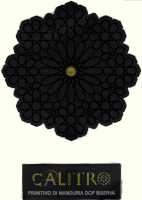
|
|
Primitivo di Manduria Riserva 2016 |
|
| Vigneti Calitro (Apulia, Italy) | |
 Primitivo Primitivo | |
| Price: € 40.00 | Score: |
 Intense ruby red and nuances of ruby red, little transparency. Intense ruby red and nuances of ruby red, little transparency. Intense, clean, pleasing, refined and elegant, starts with hints of
plum, blackberry and black cherry followed by aromas of dried violet,
blueberry, geranium, carob, chocolate, tobacco, rosemary, vanilla and
menthol. Intense, clean, pleasing, refined and elegant, starts with hints of
plum, blackberry and black cherry followed by aromas of dried violet,
blueberry, geranium, carob, chocolate, tobacco, rosemary, vanilla and
menthol.
 Properly tannic attack, however balanced by alcohol, full body, intense
flavors, pleasing roundness. Properly tannic attack, however balanced by alcohol, full body, intense
flavors, pleasing roundness.
 Persistent finish with flavors of plum, blackberry and black cherry. Persistent finish with flavors of plum, blackberry and black cherry. 12 months in barrique. 12 months in barrique. |
|
 Game, Roasted meat, Stewed and braised meat, Hard cheese Game, Roasted meat, Stewed and braised meat, Hard cheese |
|
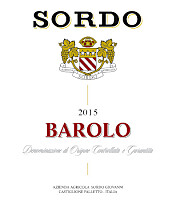
|
|
Barolo 2015 |
|
| Sordo Giovanni (Piedmont, Italy) | |
 Nebbiolo Nebbiolo | |
| Price: € 32.00 | Score: |
 Brilliant ruby red and nuances of brick red, moderate transparency. Brilliant ruby red and nuances of brick red, moderate transparency. Intense, clean, pleasing and refined, starts with hints of cherry, plum
and violet followed by aromas of raspberry, rose, tobacco, cinnamon,
chocolate, vanilla and menthol. Intense, clean, pleasing and refined, starts with hints of cherry, plum
and violet followed by aromas of raspberry, rose, tobacco, cinnamon,
chocolate, vanilla and menthol.
 Tannic attack and however balanced by alcohol, full body, intense
flavors, pleasing crispness. Tannic attack and however balanced by alcohol, full body, intense
flavors, pleasing crispness.
 Persistent finish with flavors of cherry, plum and raspberry. Persistent finish with flavors of cherry, plum and raspberry. 24 months in cask. 24 months in cask. |
|
 Game, Roasted meat, Stewed meat, Braised meat with mushrooms Game, Roasted meat, Stewed meat, Braised meat with mushrooms |
|
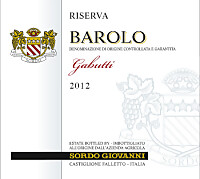
|
|
Barolo Riserva Gabutti 2012 |
|
| Sordo Giovanni (Piedmont, Italy) | |
 Nebbiolo Nebbiolo | |
| Price: € 43.00 | Score: |
 Brilliant ruby red and nuances of brick red, moderate transparency. Brilliant ruby red and nuances of brick red, moderate transparency. Intense, clean, pleasing, refined and elegant, starts with hints of
plum, cherry and dried violet followed by aromas of raspberry, dried rose,
strawberry, cocoa, tobacco, cinnamon, licorice, vanilla and menthol. Intense, clean, pleasing, refined and elegant, starts with hints of
plum, cherry and dried violet followed by aromas of raspberry, dried rose,
strawberry, cocoa, tobacco, cinnamon, licorice, vanilla and menthol.
 Properly tannic attack and however balanced by alcohol, full body,
intense flavors, agreeable. Properly tannic attack and however balanced by alcohol, full body,
intense flavors, agreeable.
 Persistent finish with flavors of plum, cherry and raspberry. Persistent finish with flavors of plum, cherry and raspberry. 48 months in cask. 48 months in cask. |
|
 Game, Roasted meat, Stewed and braised meat with mushrooms, Hard cheese Game, Roasted meat, Stewed and braised meat with mushrooms, Hard cheese |
|
|
||||||||
|
DiWineTaste Polls
|
| |||||||
Privacy Policy | |||||||


| Copyright © 2002-2024 Antonello Biancalana, DiWineTaste - All rights reserved |
| All rights reserved under international copyright conventions. No part of this publication and of this WEB site may be
reproduced or utilized in any form or by any means, electronic or mechanical, without permission in writing from DiWineTaste. |